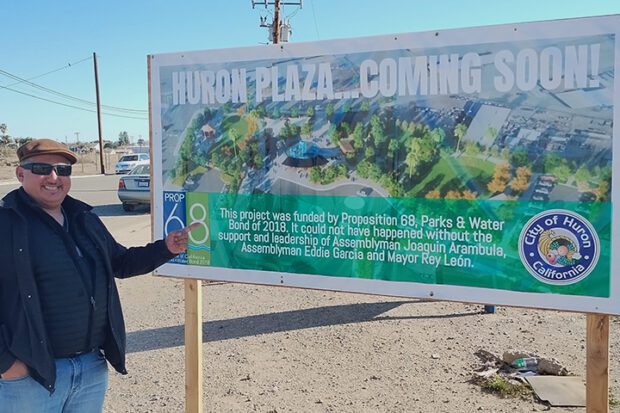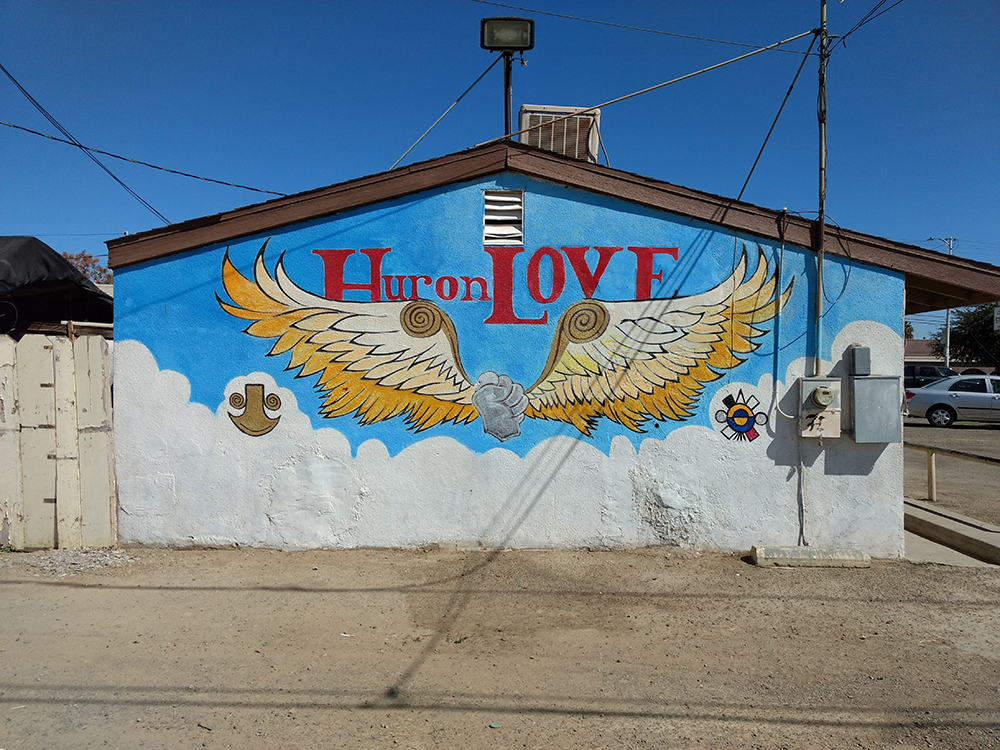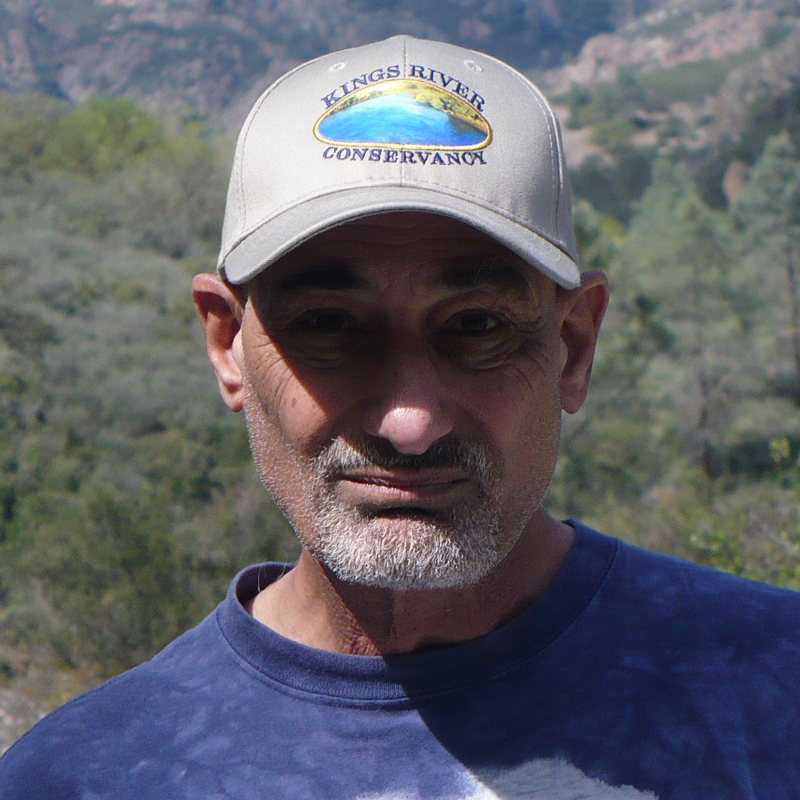
Heart of the Valley. That is Huron’s motto. The words are even emblazoned on the new bridge on State Route 269 as it crosses Los Gatos Creek just before entering town. In a very real sense, it is true. Geographically, the small farmworker town is centrally located in the San Joaquin Valley, being anywhere from 30 to 60 miles to several larger cities in the region. At the same time, there is a sense of isolation there amid so many thousands of acres of squared-off farm fields bordered by two-lane country roads.
Huron’s legacy as a city of farmworkers in the throbbing heart of Valley agriculture is also symbolic. It is the only town within the sprawling Westlands Water District. That is the nation’s largest water agency, irrigating more than a thousand square miles of cropland with precious water flowing from the state’s northern rivers through the California Aqueduct.
Like other Valley towns, Huron was established to service the Southern Pacific railroad, then developed agriculture by the dawn of the 20th century. To this day, the city’s official logo presents a cornucopia with fruit and vegetables spilling out. Then as now, farmworkers, mostly from Mexico, made those farms possible and profitable.
Rey Leon is Huron’s mayor and his roots go deep. “Pretty much my father’s been here since the late 1940s, and my family grew up here. A lot of our relatives are here. Relatives of our relatives are here, a lot of people from the region where we’re from. There’s a lot of ties going back generations and so it’s home. It’s home for all of us. And it’s a beautiful small community with a lot of heart, with a big heart.”
Leon grew up in Huron after his father came here first as a 14-year-old undocumented worker, then later in 1957 as a Bracero. Farm labor shortages spawned by World War II prompted the Bracero Program, an agreement between the United States and Mexico to recruit people to come and provide that workforce for short-term labor and low pay. The program lasted from 1942 to 1964.
That history, says Leon, is an important facet of Huron’s history. “The Braceros were the unsung heroes of World War II and the conflicts that would follow because by the millions they were here representing rail, construction, manufacturing and largely in agriculture. So, we celebrate that in Huron in September, which is our Bracero legacy month.” He even muses about having a statue in town memorializing their Bracero legacy.
Agriculture is still king around here, and Huron is at the center of action. “You know, this is truly a hub. Farmworkers from all over, all the surrounding communities, they come here, and this is where they get their ride to work. This is where the contractors come to pick up farmworkers, and farmworkers come here with the hopes that they will be able to get a job.
“So yeah, Huron is the heart of the Valley, the very center of the operation on the west side, which has the big farms. A lot of people go from here to Paso Robles, go up north, down south, across the hills to the coast to work.”

Growing up in both Huron and nearby Avenal, Leon spent his high school years in Huron so he could enroll in Coalinga High, which had a link to UC Berkeley, where he dreamed of going to college. During those college years, he would spend summers back in Huron, where he used his skills to organize health fairs for the community and started a youth group.
“Community empowerment has always been something important for me. Youth mentoring has always been a part of my personality as well. So, even when I left town, I didn’t. Then when I got the job at the UC office in Fresno, I would make sure whatever resources were available I would bring them to Huron.”
Later, Leon founded the LEAP Institute (Latino Equity Advocacy and Policy). It is an innovative approach to community development aimed at underserved populations. In their own words, the institute “works with communities to achieve economic, environmental and climate justice through leadership development, coalition building, community organizing, participatory action research and advocacy for racial justice.”
After he was elected mayor in 2016, Leon used the fundraising leverage of the nonprofit to the benefit of Huron residents. Over the years, LEAP has developed programs to monitor local air pollution and provide public investments, like a widespread ride-sharing service, solar street lighting and a community garden.
This is a sharp reversal from the reputation that stuck to Huron for a long time. And it is true that in years past it was a rough-and-tumble place with a multitude of bars along Lassen Avenue and a lot of drinking going on. Especially when the farmworker population surged to 15,000 in the harvest season. The town became known as Knife Fight City, named after a wrenching piece of photojournalism by Richard Steven Street. It exhibited a lurid aspect of Huron that showcased poverty, drug addiction and lawlessness.
Mayor Leon and Huron’s residents are now working hard to put that part of their history in the rearview mirror. The way Leon sees it, farmworkers and all of Huron’s residents deserve to have the same quality of life as other city folks. He noticed the gap when traveling to more upscale towns for meetings.
“They had their town square, they had their pharmacy, they had their little bus system. They had just everything, their own high school even. And they have all these amenities, these quality-of-life supporting institutions and infrastructure.
“Then I arrive home in Huron, and we don’t have a pharmacy. We don’t have an ambulance facility; we don’t have a high school. We don’t have a town square. We don’t have this, that and the other.
“In my opinion, farmworkers are the hardest working people on the planet. Why are these communities absent of these amenities?”
Improving the quality of life for Huron’s residents is what drives Leon’s ambition as mayor. There are a lot of ideas on the table. Some amenities are in place, Leon points out, whereas other projects are works in progress. “I was giving here, and here I am now because the community supported me and believed in me and trusted that I would bring about some change and bring about some energy.” And he has.
Perhaps the most high-profile and established service comes from the LEAP Institute’s ride-sharing operation, the Green Raiteros. The term comes from Spanglish, meaning one who gives a ride. LEAP got General Motors to provide Chevrolet Volt cars for the fleet. The popular program was detailed in the September 2021 issue of the Community Alliance newspaper. Leon explains it is the nation’s first EV ride-sharing service.
“We mostly provide rides to medical appointments, but we are gearing up to provide rides to wherever people want to go. It’s been a great service lifeline for many of our communities in five counties of the San Joaquin Valley, from Madera all the way down to Kern.
“We’ve been doing between 30,000 to 40,000 miles or more a month. And all of it is GHG free with the electric vehicles. There is no other company that’s doing this, no other nonprofit that’s doing it, especially not at the scale that we are doing it. And all of it is for rural communities. Farmworker families are the main benefactors and low-income families.”
Other civic improvements have been made as well. Next door to the LEAP office are two examples. Half the building is devoted to a shop where solar-powered lights are fabricated. Several men are busy with metal saws and welders helping light some of the darker city streets.
Next door is a community garden and composting center. It is a high-activity zone with people tending an array of raised beds while small black chickens and larger red ones scurry about pecking at food. There are piles of compost in the making and a mound of Starbucks coffee grounds. There is a greenhouse where they are doing experiments on turning food waste into liquid fertilizer.
“This was an empty lot with a bunch of old cars spilling oil,” Leon recalls. “And the owner let us use it so we were able to get the cars out. The soil here was hard as concrete.”
He explains that it took a lot of work to rehabilitate the soil by planting trees and layering in organic materials. Now, he says, “It’s a thriving community garden with a lot of greens, a lot of chiles, a lot of fruit trees. We have some chickens. And even a couple of ducks.
“We got some ceremonial white sage. We have a lot of different foods growing. We have radish, celery, strawberries, onions coming out. We have some winter crops and just a bunch of good stuff.”
It is a small step toward transforming a good idea into a reality, but the mayor is looking at future possibilities. “If every community, every neighborhood has a community garden with its chickens, then you won’t have to go to the market for your eggs and for a lot of other things.
“And the gardens are also centers of community engagement, relationship building and skills building. You learn a lot in the community garden.”
Huron is also starting to become more self-reliant by providing civic features such as a health clinic, marked bicycle lanes and finishing a new ambulance center.
Another improvement is the housing that has been built in the past few years, providing inexpensive apartments. Leon is proud of the opportunities that offers for Huron’s residents. “We have two apartment developments that are brand new, about 72 units in each one. One of them is low income, the other is affordable.
“The affordables are called Valley Village, and you pay about $700-ish for a two bedroom. And at the Commons, that is a Fresno Housing Authority development of about 72 apartments; it depends on what you earn.”
There are more projects in the works that have a longer timeline. Huron has long dreamed of having its own high school. Students now go to Avenal or Coalinga. Fifty acres of land has already been donated by Woolf Family Farms contingent on citizen approval to build the school. Leon says they are exploring a charter school, which might be easier to establish than a public high school.
Parks are in short supply in small Valley towns like Huron. Here is an opportunity to think big. Huron plans to collaborate with state agencies and Woolf Farms to transform a 3,000-acre plot of farmland north of town into a combination park and open space that would also serve to recharge groundwater. It would be funded by the state’s Multi-benefit Land Repurposing Program.
Huron would also be able to use some groundwater as a future backup supply. It would be a remarkable and well-deserved improvement for people in Huron and beyond.
The project that really lights up Leon is the creation of the town plaza that he visualizes in detail. “It is going to be a huge piece of infrastructure that will make our community that much more accommodating, comfortable and provide a green space to bring all the families together to build bonds, relationships and solidify a community culture. And that’s what the plaza is. It’s a community’s living room, where we all could share the space and enjoy life for all generations.”
Leon also envisions the plaza as a multimodal transit center along with a place that brings people together. “When you got the amphitheater with a huge green space where you could take your chairs or your quilts and enjoy a show. Maybe it’s the weekly movie night for the community, or maybe it’s mariachi appreciation month. But it will be a huge asset to the community.”
Because of the atmosphere of fear generated by the Presidential order of mass deportations, Huron recently declared itself a sanctuary city. Leon says even though it will not stop federal deportation actions, he wanted to make a gesture of support for immigrants.
“There’s people that have really reduced the amount of times that they come out into the community and support small businesses because there is this anxiety in the community. Albeit I think it’s little less of what it used to be because I think in passing the sanctuary city, it was some sort of relief, especially with my chief of police stepping up and saying, ‘we’re not going to get involved in and participate with the federal agents doing roundups or raids.’
“It was a strong gesture, a positive one, that basically was to announce to the community that your city is here as your home, as your safe space. And we will not participate in creating chaos in your family, in your life, in your community.”
Leon expresses concern about the future world that Huron’s young people will face. “We need to invest in the educational system because you can no longer think you’re going to drop out of school and have a job. They’re not going to exist. That farm labor will no longer exist.
“We need to make sure that our students are learning either a discipline or excelling academically to go to the university or learning a skill, a trade to go on to trade unions. So, we need to do a re-shifting of our social infrastructure because what we have right now, it’s been left behind long ago.”
The green economy offers additional pathways for rural youth, and Leon suggests that local community colleges could play an important role as a partner for students, “Fellowships, internships programs for STEM for the kids in the high schools and kids in the middle schools. Tutoring their younger generations. That’s what I would like to see out here.”
There is a mural called “Huron Love” on the back of a commercial building along Lassen Avenue. It is symbolic of the approach Leon has toward his community.
“This mural is about one of the many things that we want to accomplish,” he says. “I worked with kids that were part of the UC Berkeley Alternative Breaks. I painted it, and they added the color. And it represents who we are, and to a good extent why I’m here.
“You can see the fist. It’s a brown fist and wings coming out of it. It says ‘Love’ on top. And so, it’s all about empowering ourselves, empowering each other, and ascending the community, and doing it with love.”

